28 April is World Day for Safety and Health at Work. As 2019 is the International Labour Organisation’s centenary year, its theme this year is looking back over the past century as well as looking forwards to what the future of might bring.
The most reliable data for long-term comparisons are for fatal injuries because the HSE and other safety authorities think just about all fatal accidents are reported (unlike non-fatal injuries, even though there is a statutory requirement to report these too). The good news is that the number of fatalities to employees and the self-employed has fallen by nearly four-fifths in the forty-five years since the current system of regulation came into being.
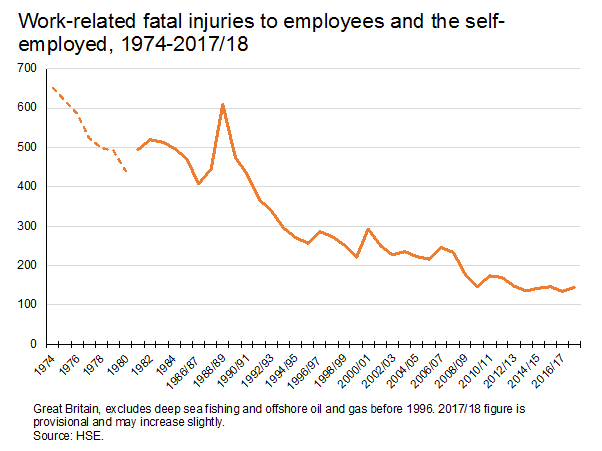
The chart excludes data on members of the public killed in work accidents because, for much of the period, these figures cannot be isolated from the (much larger) number of people killed in collisions with trains (whether accidents or suicides). All the data here exclude road traffic accidents.
Part of the explanation is the changing structure of the economy. Nowadays, fewer people work in 'high-risk' industries like agriculture and manufacturing, and more people work in service industries where they are much less likely to be killed in an accident. For example, between 1978 and 2018, employment in manufacturing fell by 60 per cent, whereas employment in services increased by 71 per cent.
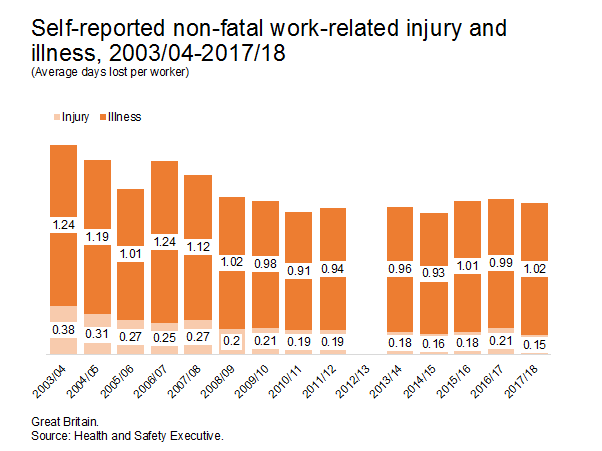
The downwards trend is less evident in broader measures of work-related injury and ill-health. The chart below presents annual estimates of the average number of days lost per worker from injuries and illnesses caused or made worse by work.
These are taken from the Labour Force Survey and hence reflect people’s own judgements about what caused their injury or made them ill. The data also are based on the views of people in work at the time of the survey; people who gave up work because of their injury or illness are not recorded.
Rates of injury and illness have been pretty flat ever since the last recession.
However, the reasons why people take time off work through illness have been changing. Days lost due to musculoskeletal problems have been falling whereas days lost due to stress, anxiety and depression have been rising since 2009/10.
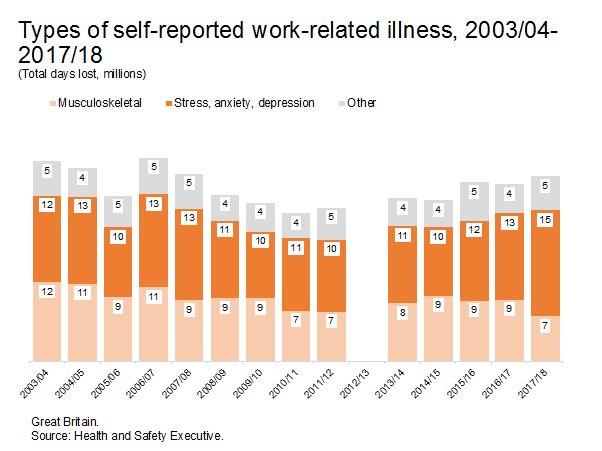
The latest figures show days lost due to stress, anxiety and depression increased by nearly a quarter in a single year. HSE point out this year-on-year increase is not statistically significant, but it is part of a longer-term pattern, with days lost being nearly three-fifths higher in 2017/18 than in 2009/10.
Of course, part of the increase could be due to a greater willingness on the part of employees to acknowledge mental health issues.
The changing structure of the economy also, again, provides part of the explanation. Rates of stress, depression and anxiety are highest in education and health, parts of the economy where employment has grown faster than average.
Nevertheless, the causes of stress are largely managerial. The chart below, using the averaged data for the three years 2009/10 to 2011/12, breaks these statistics down by cause (according to the employee).
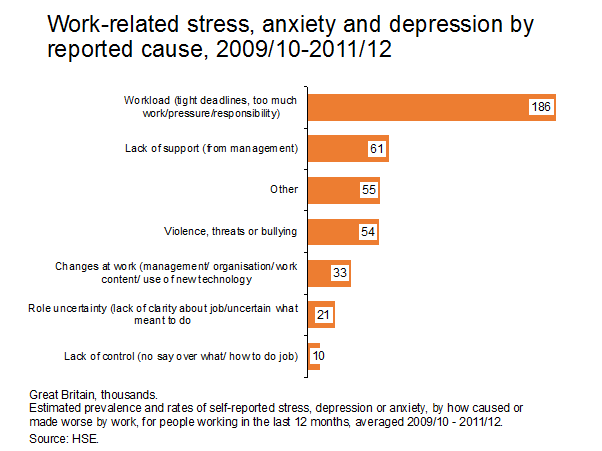
In nearly half of all cases, employees said workload was the main cause – too much work, too many deadlines, too much responsibility. The second most commonly mentioned cause was a lack of support from management.
This data is now quite old. However, results from the CIPD UK working lives survey 2018 show similar results.
For example, 47 per cent of employees who thought their workload was “far too much” said they’d experienced anxiety or depression caused or made worse by work; the corresponding percentage for employees who said their workload was “about right” was 15 per cent.
Similarly, the small minority of employees who were dissatisfied with the relationship with their manager were much more likely to report anxiety or depression.
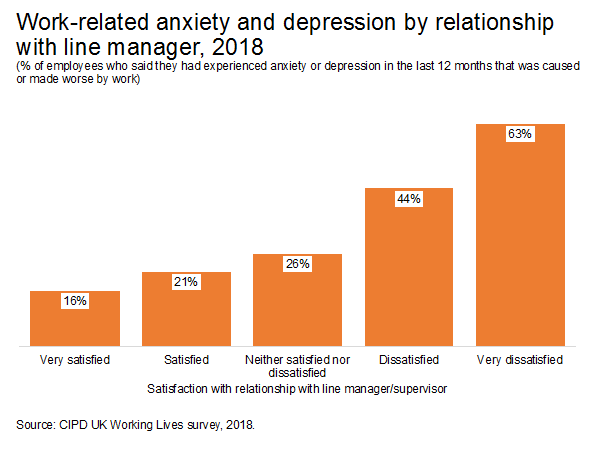
As discussed in a previous Megatrends report on work intensity, the factors that can make demanding jobs become unhealthily stressful are well known and largely in management’s control. Employers need to:
- manage workloads sensibly;
- give employees a sense of control over their situation and their job;
- ask employees for their views and listen to them; and
- make sure employees know there are people they can turn to for support.
And, of course, the law says employers should manage risks to mental health in the same way as risks to physical health.
The HSE management standards provide a sound framework for doing this yet, according to the latest CIPD/Simplyhealth health and well-being at work survey, just 15 per cent of organisations trying to tackle stress made direct use of them.
The standards may also have had an indirect effect on organisations, for example, through their impact on the advice given by occupational health specialists. Yet failure to recognise the standards risks decoupling stress prevention activities from the management systems and behaviour that often causes stress or makes it worse. No wonder less than half of organisations think their efforts to reduce stress are effective.
Topics A-Z
Browse our A–Z catalogue of information, guidance and resources covering all aspects of people practice.
Bullying
and harassment
Discover our practice guidance and recommendations to tackle bullying and harassment in the workplace.
About the author

Mark Beatson, Senior Labour Market Analyst
Mark's respected labour market analysis and commentary strengthens the CIPD’s ability to lead thinking and influence policy making across the whole spectrum of people management and workplace issues.
Prior to joining the CIPD, Mark was an economic consultant and for over 20 years worked as an economist in the Civil Service, latterly at Chief Economist/Director level, in a range of Government departments including the Department for Business Innovation and Skills (BIS), the Department for Innovation, Universities and Skills (DIUS), the Department of Trade and Industry (DTI) and HM Treasury.

Key considerations and resources to help you support your people in exceptional times

Explore our collection of resources around legal issues surrounding health and safety at work, including employers' obligations

Outlines the kind of occupational health services an organisation might offer and the role of confidentiality and consent in discussing an employee’s health


Peter Cheese, the CIPD's chief executive, looks at the challenges and opportunities faced by today’s business leaders and the strategic priorities needed to drive future success

We outline the key pieces of legislation set to come into force in the UK and explain their implications for employers and employees

We examine people’s desired hours and how this compares to the hours they actually work

Employers’ reactions to pension proposal highlight concerns over cost, while the CIPD calls for focus on raising pension awareness among staff, the need for higher contributions and better understanding of value for money